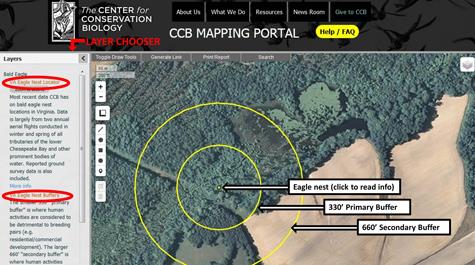CCB expands eagle nest locator to add more functions, other birds
The Center for Conservation Biology has expanded its Virginia Bald Eagle Nest Locator, an online platform launched in 2009, adding geospatial data on additional bird species as well as added functionality.
The newly launched CCB Mapping Portal is open to the public, and in addition to sites of bald eagle nests throughout the Commonwealth, the online utility now contains data on ospreys, nightjars and great blue herons and other waterbirds.
“The primary focus of the Center for Conservation Biology is the collection, interpretation and dissemination of information that is central to solving today’s environmental problems,” said CCB Director Bryan Watts. “We believe that information is vital to effective conservation and we are committed to meeting the information needs of an expanding community of end users.”
Watts said the CCB received considerable assistance from AidData, a collaborative based at William & Mary that uses advanced data techniques to track global foreign aid. Upgrades in functionality to the portal include a distance and area measuring tool, a “generate link” button that saves the current map view in the URL bar so that users can bookmark or share it with others, a “print report” button that generates a one-page pdf file, and a set of Draw Tools that allow users to add lines, shapes, and markers.
In addition to the new applications, CCB has incorporated an expanded list of data resources to the Mapping Portal, including the National Eagle Roost Registry and recent Colonial Waterbird Surveys. Watts said the nationwide eagle roost registry focuses on communal roosts used by bald and golden eagles are locations where numerous eagles spend the night. Roosts are federally protected from disturbance, and the Mapping Portal provides a topographic map along with other important information for regulators.
Waterbird species are represented in data from the CCB’s 2003, 2008, and 2013 Colonial Waterbird Surveys. All of these surveys have systematically covered all 24 species of colonial waterbirds throughout the coastal plain of Virginia, and allow for the development of conservation strategies for these sensitive populations. Layers for ongoing citizen science projects OspreyWatch and the U.S. Nightjar Survey have also been added, Watts said.
Additional information is available at the Mapping Portal FAQ page.
The Center for Conservation Biology is a joint program of William & Mary and Virginia Commonwealth University. Skip to main content
Skip to main content

